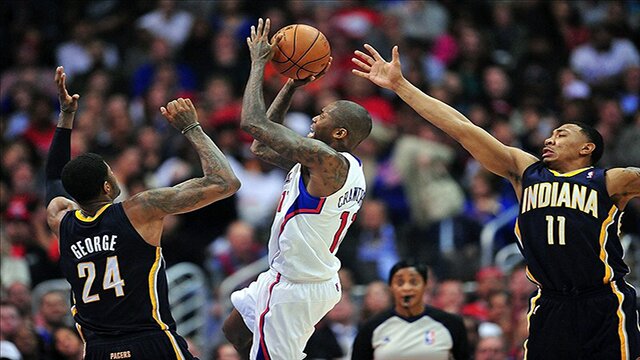It’s no secret by now that the Indiana Pacers have one of the best defenses in the NBA this season. Their ability to make scoring against them a nightmare for opposing offenses has been the most prominent reason for their success. Whether they end up as the second or third seed in the Eastern conference playoffs in roughly a week from now, their postseason lives will continue to depend on how well they defend.
But what exactly makes their defense so suffocating?
From a traditional view — whether through watching them play or looking over the basic statistics — the Pacers do stand out as one of the best in the league: first in opponent field-goal and three-point percentages, and second to only the Memphis Grizzlies in opponent points per game.
Their three main perimeter defenders, Paul George, George Hill and Lance Stephenson, are all long, athletic guys that profile as above-average defensive players for their respective positions. David West, the team’s power forward, has enough mobility to be effective in “blitzing” or hedging on ball screens which has become a staple of the team’s scheme. Finally, and probably most importantly, Roy Hibbert has become one of the elite rim protectors in the league, mastering the “2.9″ defense — which is basically camping in the paint on the weak side and being able to exit the lane before a defensive three-second violation is called.
Yet with all that, the surface has barely even been cracked on how fantastic the Pacers’ defense has been this season. Dig a little deeper and there is much more at work here.
This era of NBA offenses are pick-and-roll dominated systems that are predicated on moving the ball around the perimeter or switching the strong side of the floor with skip passes multiple times on each possession. Less isolations and straight post-ups, more passing, deception, and carefully planned shot selection.
Teams are becoming smarter with every passing day, and it shows as some have ditched traditional positions (think Miami Heat) while others have let advanced metrics mold their offensive strategies (Houston Rockets). As with just about any sport, when offenses adjust to defenses, a vice versa scenario must occur.
The Pacers have done just that this season by taking advanced statistics, creating a scheme through them, and then actually executing it while on the court.
In terms of shot locations, many clubs nowadays want open looks at the rim (obviously) and threes, while avoiding the contested mid-range jumpers as much as possible. Indiana forces more mid-range looks than any other defense in the league this season, while also ranking third in least amount of attempts in the restricted area — or essentially shots right at the rim. And when teams do get looks at the rim against the Pacers, they finish at a 54 percent clip, the lowest mark in the NBA (Hibbert effect).
Shot selection goes even further. The corner three has become one of the more popular shot locations in the pros and is even considered as the second-most valuable shot in basketball, as it’s closer to the basket than any other three-point location. The Pacers are second to only Tom Thibodeau’s Chicago Bulls in being stingy in giving up corner threes, while opponents shoot just 32.8 percent on those looks.
Sure, the Pacers aren’t the only team playing defense this way. In actuality, many are. But with that being said, a case could be made that Indiana is doing it better than anyone else this season.
In the end, it’s a perfect storm for the Pacers. A plan that is constructed through taking away the most valuable shots in basketball and excellent personnel that are perfect for executing it and are committed to playing this way.
Brandon Curry is an NBA writer for Rant Sports. Follow Brandon on Twitter @ByBrandonCurry








